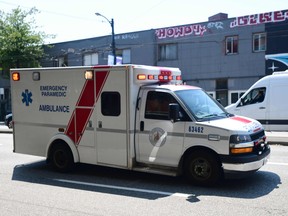Opinion: The status quo would see us prioritize restoring pavements, buildings and other hard surfaces that absorb and retain heat, but we’d be better served with more cool urban spaces during heat waves

Article content
As we approach the one-year anniversary of BC’s 2021 heat dome, the best ways to cool communities and save lives have taken on new urgency. Almost 600 people died during the event last June, and a record-smashing 49.6 C temperature was recorded in Lytton. As we enter the summer months, scientists are telling us to prepare for more extreme heat.
advertisement 2
Article content
While floods and fires may be Canada’s most costly natural disasters, extreme heat is the silent killer. To prepare, the BC government has introduced a heat alert and response system, and a BC Coroners Service report recommended changes to keep people, especially the elderly, safer. These are helpful immediate safety measures, but solutions that work with nature are among our best tools to cool areas, improve biodiversity and increase carbon storage over the long term.
Heat domes and other extreme-weather events linked to climate breakdown are not going away. The UN Intergovernmental Panel on Climate Change points to an increase throughout the 21st century in the frequency, intensity and duration of extreme-weather events, including floods, droughts and heat waves. Medical journals have called climate change the greatest threat to global health we face this century. Beyond heat-related mortality, we are seeing pregnancy complications, cardiovascular disease and malnutrition from soil depletion or limited access to traditional foods. These disproportionately affect Indigenous and poorer communities throughout Canada.
advertisement 3
Article content
Conditions are worse in urban areas during extreme heat events because of the urban heat-island effect where temperatures are significantly warmer than surrounding areas. You may recall seeing images circulating on social media last summer showing two temperature readings on the same street just blocks apart — the reading near pavement and concrete buildings often much hotter than the reading near a tree canopy or park. Consider how hot it feels at locations like the PNE in the summer.
The layer of air where most people live is the area where the effect is most pronounced. On average, the difference between surface temperatures in urban heat islands and surrounding rural areas is between 10 C and 15 C during the day. The hot surfaces in urban areas increase the experience of heat outdoors, particularly where shade is limited. Poorer and racialized communities are often in neighborhoods with less tree canopy, unventilated older buildings and combined health risk factors, making them even more vulnerable to heat and adding to inequality.
advertisement 4
Article content
Because of how advanced the climate emergency is, there is no doubt we will have to deal with climate impacts, including extreme weather, for years to come. While we can’t change this reality, we can—indeed must—adapt to it.
-
Temperatures set to soar this weekend in Metro Vancouver, as wildfire officials on alert
-
Flood Watch: North and South Thompson rivers could peak at the same time
-
BC weather: Summer starts on Tuesday … so where’s the hot sun? Why 2022 is so different from 2021
We need to expand urban forests and tree canopy, green corridors and urban parks in our communities. Expanding a green-blue infrastructure network will decrease vulnerability to urban flooding and help reduce temperatures. We should replace paved areas with natural surfaces wherever possible. Black asphalt roofs can be swapped out for green roofs or at least heat-reflecting surfaces. Heat pumps, which act as cooling devices in the summer, need to replace energy-inefficient air conditioning units.
advertisement 5
Article content
Vancouver is moving in the right direction, bringing in requirements for new multifamily and commercial buildings to include filtered air devices, to protect against pollution and particulates connected to wildfires, as well as climate-friendly cooling devices. City design also needs to consider where and how wind can provide cooling.
The status quo would see us continue to prioritize restoring pavements, buildings and other hard surfaces that absorb and retain heat. But we’d be better served with more wetlands, forests, parks and grasslands to manage stormwater and cool urban spaces during heat waves. The ability of natural ecosystems to help communities with climate adaptation is hugely undervalued. As an added benefit, permanent natural spaces absorb and hold carbon over time, doing a small part to reduce emissions that cause climate change.
advertisement 6
Article content
Nature is ready to help us adapt to a rapidly changing climate, but we need to welcome it through the front door instead of pushing it further away. The alternative will mean more reliance on already overwhelmed emergency response and health providers, an increased likelihood of preventable deaths and inadequate, unprepared responses to severe heat events like the one we experienced a year ago. All of us — especially the most vulnerable among us — deserve better.
Clarissa Samson is nature-based solutions campaign economist lead, David Suzuki Foundation. Theresa Beer is a climate policy analyst, David Suzuki Foundation.
Letters to the editor should be sent to [email protected]. the editorial pages editor is Hardip Johal, who can be reached at [email protected].
More news, fewer ads, faster load time: Get unlimited, ad-lite access to the Vancouver Sun, the Province, National Post and 13 other Canadian news sites for just $14/month or $140/year. Subscribe now through the vancouver sun or The Province.


